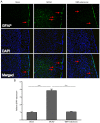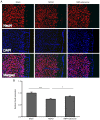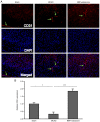Protective multi‑target effects of DL‑3‑n‑butylphthalide combined with 3‑methyl‑1‑phenyl‑2‑pyrazolin‑5‑one in mice with ischemic stroke
- PMID: 34643246
- PMCID: PMC8524408
- DOI: 10.3892/mmr.2021.12490
Protective multi‑target effects of DL‑3‑n‑butylphthalide combined with 3‑methyl‑1‑phenyl‑2‑pyrazolin‑5‑one in mice with ischemic stroke
Abstract
DL‑3‑n‑butylphthalide (NBP) and 3‑methyl‑1- phenyl‑2‑pyrazolin‑5‑one (edaravone) are acknowledged neuroprotective agents that protect against ischemic stroke. However, the underlying mechanisms of a combination therapy with NBP and edaravone have not yet been fully clarified. The aim of the present study was to explore whether the co‑administration of NBP and edaravone had multi‑target protective effects on the neurovascular unit (NVU) of mice affected by ischemic stroke. Male C57BL/6 mice were randomly divided into the following three groups: i) Sham operation control, ii) middle cerebral artery occlusion (MCAO) and reperfusion, iii) and MCAO/reperfusion with the co‑administration of NBP (40 mg/kg) and edaravone (6 mg/kg) delivered via intraperitoneal injection at 0 and 4 h after reperfusion (NBP + edaravone). After ischemia and reperfusion, infarct volumes and neurological deficits were evaluated. The immunoreactivity of the NVU, comprising neurons, endothelial cells and astrocytes, was determined using immunofluorescence staining of neuronal nuclei (NeuN), platelet and endothelial cell adhesion molecule 1 (CD31) and glial fibrillary acidic protein (GFAP). Western blotting was used to detect the expression levels of apoptosis‑related proteins. The infarct volume, neurological function scores and cell damage were increased in the MCAO group compared with the sham operation group. Furthermore, the MCAO mice had reduced NeuN and CD31 expression and increased GFAP expression compared with the sham group. By contrast, the NBP + edaravone group exhibited reduced cell damage and consequently lower infarct volume and neurological deficit scores compared with the MCAO group. The NBP + edaravone group exhibited increased NeuN and CD31 expression and decreased GFAP expression compared with the MCAO group. Furthermore, the expression levels of Bax and cleaved caspase‑3 in the NBP + edaravone group were decreased significantly compared with the MCAO group, while the expression levels of Bcl‑2 and mitochondrial cytochrome c were increased. In conclusion, the results of the present study demonstrated that NBP and edaravone effectively prevented ischemic stroke damage with multi‑target protective effects. In addition, NBP + edaravone may be a promising combination therapy for ischemic stroke.
Keywords: 3‑methyl‑1‑phenyl‑2-pyrazolin‑5‑one; NBP; NVU; combination therapy; ischemic stroke.
Conflict of interest statement
The authors declare that they have no competing interests.
Figures







Similar articles
-
A comparative study of the neuroprotective effects of dl-3-n-butylphthalide and edaravone dexborneol on cerebral ischemic stroke rats.Eur J Pharmacol. 2023 Jul 15;951:175801. doi: 10.1016/j.ejphar.2023.175801. Epub 2023 May 18. Eur J Pharmacol. 2023. PMID: 37207969
-
L-3-n-Butylphthalide reduces ischemic stroke injury and increases M2 microglial polarization.Metab Brain Dis. 2018 Dec;33(6):1995-2003. doi: 10.1007/s11011-018-0307-2. Epub 2018 Aug 16. Metab Brain Dis. 2018. PMID: 30117100 Free PMC article.
-
Protective effect of 4-Methoxy benzyl alcohol on the neurovascular unit after cerebral ischemia reperfusion injury.Biomed Pharmacother. 2019 Oct;118:109260. doi: 10.1016/j.biopha.2019.109260. Epub 2019 Aug 29. Biomed Pharmacother. 2019. PMID: 31548176
-
Potential of Edaravone Dexborneol in the treatment of cerebral ischemia: focus on cell death-related signaling pathways.Mol Biol Rep. 2024 Sep 23;51(1):1007. doi: 10.1007/s11033-024-09952-1. Mol Biol Rep. 2024. PMID: 39312062 Review.
-
Recent Advances and Therapeutic Implications of 2-Oxoglutarate-Dependent Dioxygenases in Ischemic Stroke.Mol Neurobiol. 2024 Jul;61(7):3949-3975. doi: 10.1007/s12035-023-03790-1. Epub 2023 Dec 2. Mol Neurobiol. 2024. PMID: 38041714 Review.
Cited by
-
Efficacy of Butylphthalide in Combination with Edaravone in the Treatment of Acute Ischemic Stroke and the Effect on Serum Inflammatory Factors.Dis Markers. 2023 Apr 11;2023:9969437. doi: 10.1155/2023/9969437. eCollection 2023. Dis Markers. 2023. Retraction in: Dis Markers. 2023 Dec 13;2023:9761940. doi: 10.1155/2023/9761940. PMID: 37082457 Free PMC article. Retracted.
-
Recent developments in the design of functional derivatives of edaravone and exploration of their antioxidant activities.Mol Divers. 2025 Apr;29(2):1895-1910. doi: 10.1007/s11030-024-10940-7. Epub 2024 Aug 5. Mol Divers. 2025. PMID: 39102113 Review.
-
Synthesis, Characterization and Assessment of Antioxidant and Melanogenic Inhibitory Properties of Edaravone Derivatives.Antioxidants (Basel). 2024 Sep 23;13(9):1148. doi: 10.3390/antiox13091148. Antioxidants (Basel). 2024. PMID: 39334807 Free PMC article.
References
-
- Benjamin EJ, Muntner P, Alonso A, Bittencourt MS, Callaway CW, Carson AP, Chamberlain AM, Chang AR, Cheng S, Das SR, et al. Heart disease and stroke statistics-2019 update: A report from the American heart association. Circulation. 2019;139:e56–e528. doi: 10.1161/CIR.0000000000000659. - DOI - PubMed
-
- GBD 2017 Disease, Injury Incidence, Prevalence Collaborators. Global, regional, and national incidence, prevalence, and years lived with disability for 354 diseases and injuries for 195 countries and territories, 1990–2017: A systematic analysis for the global burden of disease study 2017. Lancet. 2018;392:1789–1858. doi: 10.1016/S0140-6736(18)32279-7. - DOI - PMC - PubMed
-
- Zhang JJ, Liu X. Aspirin plus dipyridamole has the highest surface under the cumulative ranking curves (SUCRA) values in terms of mortality, intracranial hemorrhage, and adverse event rate among 7 drug therapies in the treatment of cerebral infarction. Medicine (Baltimore) 2018;97:e0123. doi: 10.1097/MD.0000000000010123. - DOI - PMC - PubMed
MeSH terms
Substances
LinkOut - more resources
Full Text Sources
Medical
Research Materials
Miscellaneous

